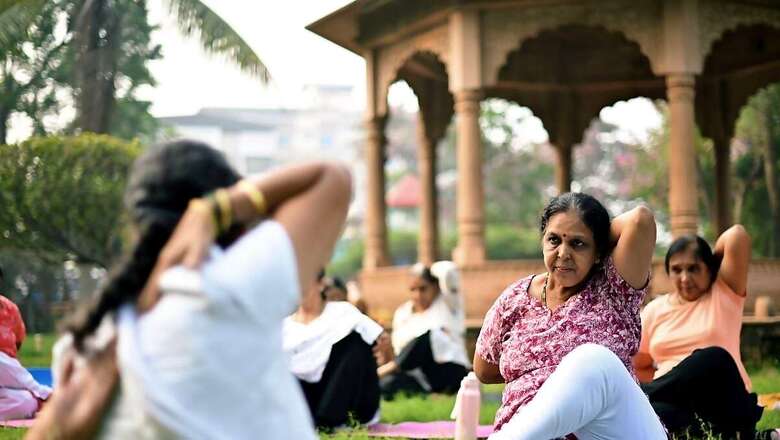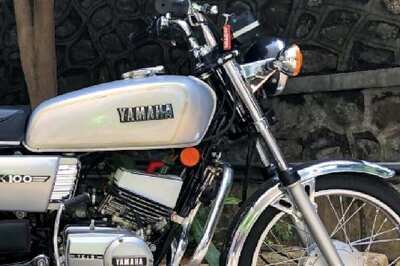
views
Most elders, aware that they need movement, are regular with walks and do some loosening and breathing exercises. However, when it comes to Yoga, very few seem to understand the long-term benefits of the practice.
NOT JUST FOR THE YOUNG
Yoga is often considered a “young person’s thing”. Dr Hansaji Yogendra, Director of Yoga Institute, Santacruz, Mumbai, refutes this concept. “There is no age-limit for practising Yoga. While some advanced poses may become more challenging, practices can easily be adapted to suit the elderly.”
She added: “Yoga is a lifelong journey that evolves with you as you age, providing physical, mental, and emotional benefits at every stage, and opportunities for spiritual growth, meditation, and self-awareness at any age. People can enjoy its benefits through their lives. You continue to deepen your practice as you age.”
Even a really short Yoga session works wonders in adding energy and taking care of minor troubles.
MUST-DO YOGA POSES FOR SENIORS
Dr Hansaji suggests some Asanas that can be done sitting on a chair and in lying-down position. These, she assures, are “enough in themselves and will take care”.
These poses help to: a) loosen the joints and stretch the limbs, thus reducing stiffness and improving circulation; b) stretch the abdominal muscles and reduce constipation and improve digestion; c) ease back pain and also anxiety and stress that we tend to store in our lower spine; d) improve strength, resilience and boost immunity.
Yastikasana (Stick pose)
1. Lie on your back, hands beside the body, legs stretched out, feet together. Keep the mind relaxed.
2. Inhaling, in 3 seconds, stretch the body, toes and fingers pointing outwards, as if trying to reach something farther away.
3. Simultaneously, raise both hands parallelly in a semi-circular arc, and place them on the ground above the head.
4. Synchronise the movement of arms and feet.
5. Maintain the stretched position for 6 seconds.
6. Exhaling, in 3 seconds, return to the starting position, with hands beside the body and relax.
7. This completes one round. Do 4 rounds.
Lying-down Bhadrasana (Variation of Throne Pose/ Butterfly Pose)
1. Lie on your back and stretch the legs fully, hands placed on the abdomen, all parts relaxed.
2. While inhaling, in one smooth movement, bend the legs at the knee (the knees pointing outward) and bring the feet together in a `Namaste’, joining the soles, toes, and heels.
3. Maintain the pose for 4-5 seconds and then exhaling, stretch out the legs.
4. Do 4-5 times or as comfortable.
Pavanmuktasana (Wind-relieving pose)
1. Lie on the back, feet together, hands resting beside the body.
2. Exhaling, in 3 seconds, bend and draw the right knee towards the chest and clasp with both the hands. Wrap the arms just below the knee and firm pressed against the chest.
3. Ensure the head and neck remain on the floor, and the left leg is straight.
4. Maintain this pose for 6 seconds with breath suspended, or with normal breathing — as the doctor orders.
5. Inhaling, in 3 seconds, release the clasped hands, straighten the leg and return to the starting position.
6. Repeat with the left leg to complete 1 round. Do 3 rounds each.
7. Follow with 2-3 rounds of both legs together: bend and clasp with both arms while exhaling; release with inhalation.
Parvatasana on the Chair
1. Sit on a chair, neck and back straight, eyes focused on a point in front, feet placed on a folded rug on the floor.
2. Inhaling, in 3 seconds, raise both the arms together from the sides, for an upward stretch.
3. Join the palms in this stretched position. Ensure the hands are close to the ears, the back is straight, and arms are not bent at the elbows and wrists.
4. Maintain this stretched position for 6 seconds.
5. Exhaling, in 3 seconds, turn the palm outwards and bring the arms down to the sides to complete 1 round.
6. Do 4-5 rounds.
(Note: This list is indicative. Remember to check with your healthcare provider or physician, keeping in mind your limitations and health condition, before incorporating them in your routine. Importantly, learn the poses from a trained Yoga teacher first.)
LIFESTYLE AND PRECAUTIONS – GENTLE REMINDERS
Sahaj-bhav Asanas: When sitting on a chair, perform ‘loosening exercises’ for fingers, wrists, elbows, shoulders, knees, ankles, and toes. Also, gentle neck movements — up-and-down and left-to-right.
Warmth is important: A gentle reminder to not skimp on warm clothes, and especially to keep the head covered when stepping out. Avoid going out in windy weather. Take in the Sun’s energy.
Nutrition cannot be overemphasised: Nutrient deficiencies cause more severe problems in an old body. Hence, choose food items carefully, so that all nutrients are adequately included. Evening meals are preferably kept light.
Movement and self-reliance: Walking is a good exercise, not to be missed. Equally important is moving around in the house, not being dependent on others for everything and being self-reliant. The body’s language must be understood and heard carefully, of course, and elders must function accordingly.
Pranayamas for life-energy: Pranayamas such as deep abdominal breathing, Anulom-vilom and Bhramari are particularly good. They help induce sleep, relieve stress, improve digestion, and have a long-term beneficial effect on nerves.
Final Word: Hansaji also recommends chanting `Om’ to keep the mind positive with the constant feeling of surrendering to the Higher Power.
The author is a journalist, cancer survivor and certified yoga teacher. She can be reached at [email protected].




















Comments
0 comment